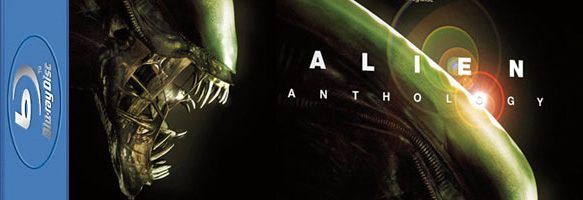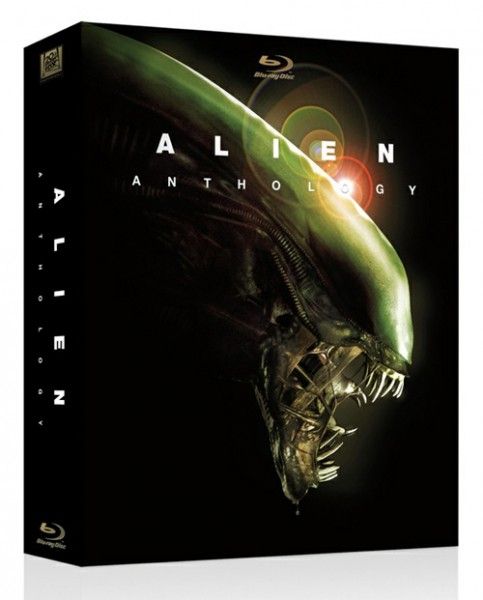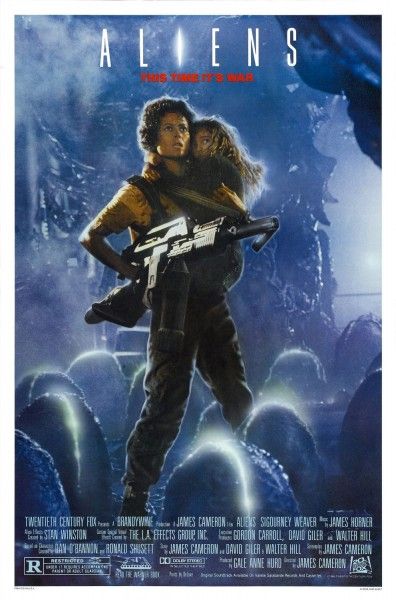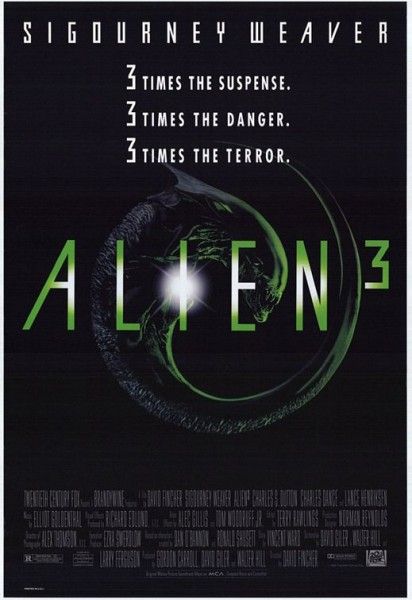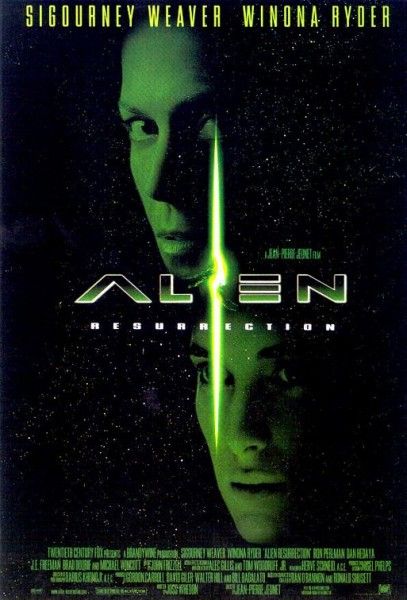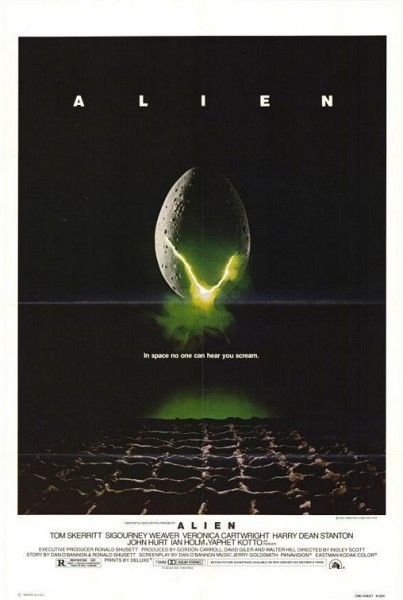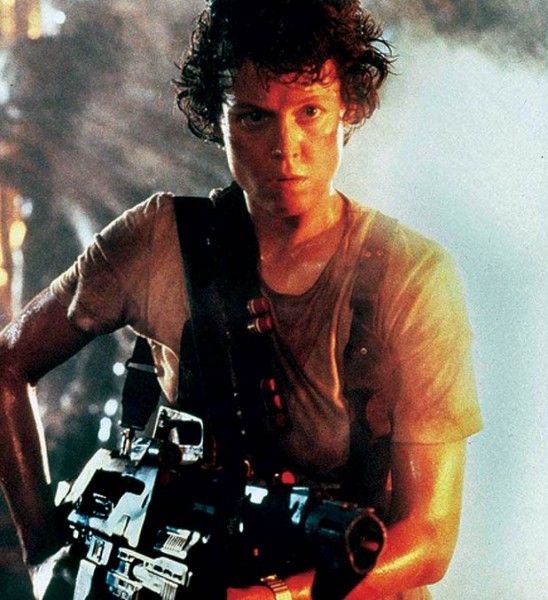Holy God. That’s one of the first reactions one has to 20th Century Fox’s six disc Blu-ray release of the Alien Anthology. It was put together by Charles de Lauzirika, and he’s the guy who’s been doing all the supplements for this franchise for years now, including the awkwardly named Alien Quadrilogy. His task was to make a collection that had not only improved picture and sound quality, but all the supplements of previous releases, and even more additional content. He and his team delivered; this is the mother lode. Of course, the series is also presented immaculately, with each film offering two cuts, deleted scenes, commentaries and isolated scores. The six disc set has over 60 hours of supplements. It’s mind-boggling and overwhelming, but also the perfect franchise for this sort of study, and it’s perfect for Blu-ray. Our humbled review of the Alien Anthology Blu-ray set follows after the jump.
The big news: Aliens has never looked this good, outside of theatrical presentation. The film was shot on a Kodak film stock that proved to be exceptionally grainy, and problematic for Blu-ray releases. If you saw Fox’s previous release of Predator, there was a reason to be worried, as scrubbing the film can lead to a plasticized look. On top of great transfers for all the films, there’s even more supplements than the previous nine-disc DVD release. This looks and smells definitive.
Okay, Alien. There’s a crew (John Hurt, Sigourney Weaver, Tom Skerritt, Yaphett Kotto, Veronica Cartwright, Ian Holm, and Harry Dean Stanton) on board a space ship. Everyone’s in hyper sleep when “the company” – their ominous employer - wakes them up to check on a distress signal. They investigate, and John Hurt’s character Kane comes back with an alien attached to his face. Any attempt to remove the alien will either kill Kane, or cause the Alien to bleed its molecular-acid blood. Kane wakes up a little bit later, and when his lunch doesn’t agree with him it turns into in one of the great shock scares in cinema history. From there the rest of the crew tries to figure out some way to stop the alien from killing them all. But not only do they not have a lot of weapons, one member of their team is working against them and the company views them as disposable.
It’s – as Dan O’Bannon puts it – an old dark house in space, but that doesn’t give enough credit to Ridley Scott. Horror really is a director’s medium, and this film is a master’s work of tension. Scott always likes to talk about The Texas Chain Saw Massacre as the greatest influence on this film - and he has a point - but the main influence seems to be Tobe Hooper’s understanding that suggestion is more chilling than gore. What little violence is shown is cut to be nearly subliminal, but those frames linger: the shot of Alien outstretching its hands to grab a crew member, or its sexually leering tail. Watching the supplements, some of the magic of the creature goes away as they had a hard time getting it to move (shades of the Shark in Jaws), but such only speaks to the film makers craftsmanship. Alien may just be a slasher in space, but it’s also a perfect movie. And Scott creates a world here, one that is filthy and lived in, but also visually overwhelming (in the best possible way).
Aliens, though arguably more a roller coaster ride than anything else, still packs a wallop. It’s also one of the great sequels because it changes the stakes and tone but still feels of the universe. Returning cast member Weaver joins a squad of Space Marines (including Michael Biehn, Bill Paxton, Jenette Goldstein, and Mark Rolston) an android (Lance Henriksen) and a corporate executive Carter Burke (Paul Reiser) in reinvestigating the planet where they found the alien. Weaver’s Ripley was lost in space for 57 years, and in that time the planet LV-426 has been turned into a mining facility with a over a hundred colonists. But when the marines land, there’s nobody there except a little girl named Newt (Carrie Henn), who is ghostly. Eventually (and it’s amazing that it takes an hour, but that hour is never dull), they find what’s happened to the colonists: they’ve been cocooned and used to produce an army of Aliens. And when the marines go up against them, they’re overwhelmed. Now, with only a handful of soldiers, Ripley suggests they nuke the planet from orbit, which pisses off Burke. But to leave they’ve got to remote pilot a ship to their location, and the nuclear core of the planet has been ruptured, so they’re running out of time. And the aliens know they’re there, so they can’t just wait it out quietly.
Though the characterization is cartoonish, and most of the marines are kept one-dimensional, this is a textbook example of how to make an action film. Build your tensions, and then keep upping the stakes. It’s hard for me to be objective with the film - as a child I ended up watching this film on a loop as often as I could. It was pulse-pounding entertainment at its finest. And though it’s hard to go to the well again and again when you’ve imprinted a film on your DNA, watching it in this beautiful new transfer, I was taken in and marveled at how much fun the whole thing is. Cameron can’t replicate the initial horror, so this is more about claustrophobia. But then also, he makes Ripley a strong female character, determined to protect her surrogate daughter, so you’ve got a great protagonist in the middle of all this action.
On the “Ripley as mother” angle, I’ve seen the film numerous times, and I got the laserdisc back in the day, which had the extended cut (included here). Though I was happy to see the additional footage, it does two things I don’t care for: it over-explains why Ripley latches on to Newt (she had a daughter of her own), and it goes to LV-426 before Ripley does. I’ve never liked that latter decision: we know what’s coming, but it’s more fun to experience it with Ripley. It also distends the opening sequence, which is already on a slow ramp up. Cameron has always been a master of pacing, and like most of his great action films, he understands build. Too many modern films don’t understand escalation. I think part of the reason why the Director’s cut is so beloved is because it adds more, not necessarily because it’s better, though I know a lot of fans of the Sentry guns section of the extended cut.
It helps to have characters to latch on to. Paxton’s Hudson might be lightly sketched but Paxton gives it an intensity and great flavor. His character might read as cowardly, but he’s also another audience surrogate, and after his friends are decimated, his reticence is not without reason. Beihn gives a similar performance as he did in Cameron’s previous film The Terminator as the sensitive warrior, but he does it well, and the chemistry between him and Ripley is palpable. She might be more outwardly masculine (and he is the woman of the relationship), but he offers a steady command when put in charge. Aliens is the perfect thrill ride.
When I first saw Alien 3, like many – actually, most audience members – I was slightly insulted. I loved the second film, and at the time loved it more than the first film (I think I’ve flopped), and the third movie begins by killing off all other survivors besides Ripley. Not only that, Ripley proceeds to perform an autopsy on one of the dead. But at the time David Fincher was an upstart music video director, best known for ripping of Fritz Lang in Madonna videos. On some level I think the critical reaction to Se7en was so favorable because they were surprised it was the same director as Alien 3. This time Ripley (now with a first name: Ellen) is on a prison planet, and there was an egg or two on her ship. And so there’s an alien on the planet, but – because there’s only a handful of prisoners and a custodial staff - there’s no weapons. And the big reveal: Ripley has an alien mother in her chest.
Alien 3’s reputation came to blossom upon the release of Alien: Resurrection, in that what it accomplished could be put in perspective. And for that you have a director applying his vision of what an Alien sequel should be. The production was troubled - to say the least - but there are a lot of great things in the film, even if the final third of the movie follows a bunch of bald headed guys you don’t really know running around golden-brown air ducts. The concept for this film, at least in its finished form, is that you can’t battle the devil and expect to keep winning. This film - and the monster has elements of cancer and A.I.D.S. or whatever foreign body disease you want to lay on top of the film for metaphorical purposes – is about dying. And though that may be a huge disappointment in terms of what came before, it seems the most logical way to end the franchise. In the end Ripley is stripped of everything, her friends, her hair, anyone close to her, and does the only logical thing: she dies on her own terms. Of course, this is muddled by the action-y premise of the conclusion, but it’s a dark vision when it’s firing on all cylinders. And now it seems perfect in context of the franchise.
This film has an extended cut that at least does a better job of differentiating the characters a bit, and smoothing some things out. I don’t know if I prefer it to the theatrical version, but it is the one I usually watch. Alien 3 is a flaws and all experience, and there are some things that are obviously bad and awkward about the film, but it also shows that Fincher was going to be a great director, something he’s proved time and time again.
Alien Resurrection is as naked as its title. The premise here is that Ripley has been cloned to get the mother Alien growing inside of her, which leads to both parties swapping some DNA. She’s on a military ship, which ditches the Corporation from the original (Weyland-Yutani) for a militaristic entity interested in the biomechanical benefits of aliens. On to their ship comes a group of pirates (including Michael Wincott and Ron Perlman), who also have a woman with them named Call (Wynona Ryder), who’s got a secret. The Military (headed up by Dan Hedeya and J.E. Freeman) see that Call is a saboteur, which leads to conflict, but then some aliens get loose. So you’ve got a group of people who don’t really like each other stuck together fighting aliens, and trying to get off a ship. But the DNA tampering has led to some modifications of the aliens, and eventually leads to a new strain of the species.
This was directed by Jean-Pierre Jeunet, and he was coming off some highs with Delicatessen and City of Lost Children. He’s like a nicer Terry Gilliam. With Alien Resurrection he was paired with a script by Joss Whedon. Whedon’s cinematic output has been lacking to this date, and here everything feels like the first draft of Firefly/Serenity. The entire pirate crew can mostly be transposed on to those characters, with Perlman and Wincott the most obvious, and Call quite River Tam-ish. Unfortunately, this is the first Alien movie that feels kind of same-y in structure and plotting. Though the series has always had that Ten Little Indians structure where cast members are going to slowly but surely be eliminated, the run through the ship feels very familiar to the other films, and a lot of things feel like redresses of moments from the first two movies.
And to that, Jeunet doesn’t have the temperament or disposition for horror. There are a number of moments that play the death as comedy, and there’s a lot of pith from the performers. This may also have to do with Whedon’s screenplay. Whedon has gone on record as saying it wasn’t his fault with this movie, but there’s a lot of his feel on the film and a lot of the stuff that feels most him is the stuff that painfully doesn’t work. Though the third film had a lot of studio interference, this is the one that seems most victim to the notes process during the scripting stage. There are some really great things and ideas in the film: when Ripley confronts the unsuccessful clones of herself, the underwater fight against the aliens, and the scene where a man is told exactly what happened to him (he was impregnated with an Alien) are kind of great. But even these moments are at times undercut by the film itself. The film goes into a third act that must have seemed smart at some point, where there’s an alien/human hybrid that’s fleshier. But from the second this character is introduced, the film becomes so painfully misguided, and as the film comes to its conclusion that creature’s end manages to be painful to watch in a way that would make sense if the film had earned that moment. Even if the idea of a half-human alien and “empathy for the monster” are compelling thoughts, they are undercut by the goofiness of its demise. Also, Weaver painfully overacts her “alienness” which has her sniffing things, and mostly being a preternatural bitch. Ripley in the previous incarnations was weak; here she’s inhuman to the point of distraction. I’ve tried with this movie since I saw it theatrically, but it comes across as a hundred bad decisions mixed in with a handful of good ones.
Now, on to the meat! On disc one is Alien. The film is presented in widescreen (2.35:1) and in 5.1 DTS-HD surround. Also included is the original 4.1 Dolby surround mix from the 1979 theatrical release. The film looks absolutely gorgeous; the transfer is new and seems vastly improved over the previous DVD editions. With this film the clarity is great, as there is so much set detail, and the black levels are perfect, while the 5.1 surround track is enveloping. Both the theatrical cut (117 min.) and the 2003 Director’s cut (116 min.) with Ridley Scott introduction (1 min.) are included. The theatrical cut comes with a commentary from 2003 with Director Ridley Scott, Writer Dan O’Bannon, Executive Producer Ronald Shusett, Editor Terry Rawlings, Sigourney Weaver, Tom Skerritt, Veronica Cartwright, Harry Dean Stanton and John Hurt. Then there’s also the 1999 audio commentary with Scott by himself, the final theatrical isolated score in 5.1 Dolby Digital, and the composer’s original Isolated Score in 5.1 Dolby Digital. Also on this disc is a deleted scenes marker.
All film come in MU-TH-ER Mode which points you to interesting related supplements on Discs five and six, and what’s happening in the commentary, etc. The marker system was also used previously on Minority Report and Gladiator Blu-rays, and with something similar on Fight Club. I think this is interesting, but I prefer to know that I’ve watched everything.
Disc two has Aliens, which is presented in widescreen (1.85:1) and in 5.1 DTS-HD, and the film’s original 4.1 Dolby surround. As I said before this is the premiere version of this movie, and it wipes away all previous home video incarnations. The soundtrack is also excellent, with great use of the surrounds for the film’s atmosphere. This disc has both the theatrical (138 min.) and the director’s cut (155 min.) with director introduction (1 min.). The film also comes with the 2003 commentary with Director James Cameron, Producer Gale Anne Hurd, Alien Effects Creator Stan Winston, Visual Effects Supervisors Robert Skotak and Dennis Skotak, Miniature Effects Supervisor Pat McClung, Actors Michael Biehn, Bill Paxton, Lance Henriksen, Jenette Goldstein, Carrie Henn and Christopher Henn. Also included is the final theatrical isolated score, and the composer’s original isolated score, along with a deleted scenes marker and MU-TH-ER Mode.
Disc three has Alien 3, and the film has always been dark and moody, so the new transfer definitely benefits the film .The film is presented in both the theatrical cut (115 min.) and the extended work print version (145 min.) in 5.1 DTS-HD surround. Again, the work here is excellent, and the film looks better than it ever did. This comes with a 2003 commentary with Cinematographer Alex Thomson, B.S.C., Editor Terry Rawlings, Alien Effects Designers Alec Gillis and Tom Woodruff, Jr., Visual Effects Producer Richard Edlund, A.S.C., Actors Paul McGann and Lance Henriksen, and the film’s isolated score in 5.1 Dolby Digital, and a deleted scenes marker.
Disc four is Alien: Resurrection, in both the theatrical (109) and extended cut version (116 min.) with director introduction (1 min.). Both versions come in 5.1 DTS-HD surround and widescreen (2.35:1). As this is the newest film of the bunch, it’s not surprising that it’s in great shape. There’s a commentary with Cinematographer Alex Thomson, B.S.C., Editor Terry Rawlings, Alien Effects Designers Alec Gillis and Tom Woodruff, Jr., Visual Effects Producer Richard Edlund, A.S.C., Actors Paul McGann and Lance Henriksen, the film’s Theatrical isolated score in 5.1 Dolby Digital, and a Deleted Scene Marker.
Disc five contains all the feature length documentaries on the films, all in widescreen (1.78:1) but standard-def. The documentary for Alien is called “The Beast Within: Making Aliens” (177 min.), which comes with enhancement pods, that are extended bits (80 min.). So there’s four pus hours of doc footage on the first film. This making of doc covers everything you could possibly want to know about the making of and everyone is delightfully bitchy. Dan O’Bannon thinks they messed with his script, while David Giler says that O’Bannon’s script was garbage except for the big takeaway (the chestburster), while Ridley Scott has no problem talking about what sequences he thinks are a bit dodgy. This is a full meal, and the film is old enough so people are willing to piss on each other a little.
For Aliens, the documentary is titled Superior Firepower: Making Aliens” (185 min.), which also comes with enhancement pods (59 min.). So again, over four hours of documentary footage on the film. What you get out of this is that Cameron is a really smart asshole, but also that – like the third film – they got stuck behind a release date, which crunched the post production. But this film was considered a big winner, so everyone’s really happy about it. But Cameron’s on-set behavior definitely gets brought up and you can see both sides of it.
The gem of the collection though is easily the Alien 3 the documentary “Wreckage and Rage: Making Alien 3” (181 min.) which comes with enhancement pods (74 min.). Here you get both Renny Harlin and Vincent Ward talking about their aborted premises for the film, and the work they did, and Fox executive Jon Landau states that with this film they were gunning for a release date. David Fincher declined participation, but it covers his hiring, and why Jordan Cronenweth had to leave the production (health issues). It also suggest why the film is as good as it is – Fincher knew he would be left alone while shooting, though they wrapped production before the film was finished and went through a couple rounds of reshoots. No one shies away from shit talking the film, or the problems they encountered, which makes the film come off better than it did before. This was a nightmare studio project, and “Wreckage and Rage” shows how wrong a production can go.
Alien Resurrection’s doc is much tamer, it’s called “One Step Beyond: Making Alien Resurrection” (174 min.) with enhancement pods (75 min.). It’s also honest, but it doesn’t have the same story to tell. This wasn’t as troubled, it’s just not a great movie, which some of the commentators acknowledge, while Whedon does his normal deflections. That man’s a natural born blame thrower.
Disc six is broken up into five categories, one for each movie, and one for Anthology stuff. All films are broken into three sections: Pre-production, Production, and Post-Production and Aftermath. For Alien in “Pre-“ is the first draft of the script by Dan O’Bannon, Storyboards and Ridleygrams, Conceptual Art, five of Sigourney Weaver’s Screen tests (9 min.), with three having commentary by Ridley Scott, and cast photos. “Production” has a multi-angle presentation on the chest burster scene (5 min.), a video graphics gallery, and four still galleries, including one for H.R. Giger’s studio. “Post” has seven additional deleted scenes (17 min.), with three of the scenes presented in 5.1 surround. There’s a still gallery, a 1979 making of (7 min.), and all of the content of the special edition laserdisc. Also included is a documentary called “The Alien Legacy” (67 min.) about the making of the first film with comments from O’Bannon, Shusset and Scott, a Ridley Scott Q&A at the Egyptian (16 min.), two trailers, and two TV spots.
For Aliens in “Pre-“ there’s Cameron’s original treatment, a multi-angle pre-viz videomatics with optional commentary by miniature effects supervisor Pat McClung (3 min.), storyboards and art, and a cast portrait gallery. “Production” has four still galleries, and the film’s in-feature video content, like the helmet cams and background screens (13 min.). “Post-“ has two deleted scenes, the first the Burke Cocoon sequence (2 min.), the second a footage montage (4 min.) of scrapped things. There’s an image gallery, the laserdisc archives, a look at the title design, an Aliens-inspired ride called “Aliens: Ride at the Speed of Fright” (8 min.), four trailers, and a TV spot.
For Alien 3, in “pre-“, there’s a storyboard archive, and two conceptual art galleries. In “Production” there’s a construction time-lapse sequence (5 min.) and an EEV bioscan multi-angle piece (2 min.) with Alec Gillis commentary. There are also two still galleries. In “Post-“ there’s two still galleries, and an advance featurette (3 min.), a making of (23 min.), five trailers, and seven TV spots. For Resurrection, in “Pre-“ there’s the first draft by Joss Whedon, two bits of test footage (15 min.), and a multi-angle pre-viz (3 min.), storyboards, and two conceptual art galleries. In “Production,” there’s two still galleries, and in “Post-“ there’s two still galleries, an HBO making of (26 min.), a featurette (4 min.), two trailers, and four TV spots.
Then in Anthology is the documentary “Alien Evolution” in its TV cut (49 min.) and an extended cut (65 min.) which covers the first film most extensively and then the sequels, with the usual suspects (O’Bannon, Scott), the documentary "The Alien Saga” (109 min.) which covers the whole franchise, the “Aliens 3-D Attraction” script and art for a Korean amusement park. “Aliens in the Basement: The Bob Burns Collection” talks to famous movie enthusiast Bob Burns about what Alien props he has in his collection (17 min.), then there’s clips from Family Guy (1 min.) and Spaceballs (2 min.) that mocked the movie, the latter with John Hurt. There’s a Dark Horse still gallery, and a patches and logos gallery, and that winds out the set. Then there’s at least four Easter Eggs, which replicate the eggs from the previous releases. There are a couple of things missing – Weaver talked about recording commentaries for the films, but that obviously didn’t happen, and supposedly there was more James Remar footage to be included, but these are minor details. My god, this set is overwhelming. And that’s exactly as it should be. Right now, this is the best Blu-ray set yet produced.

